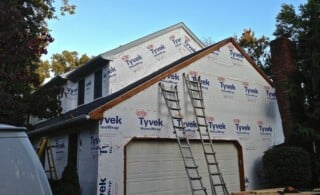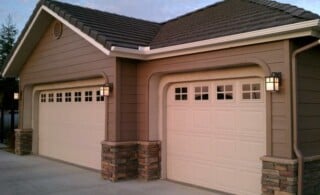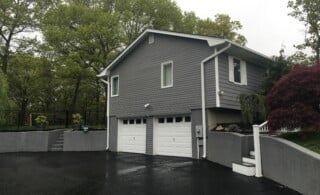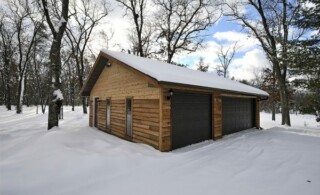Whether you’re using wood, metal, vinyl or Hardiplank siding, it’s a good idea to measure your exterior walls before calling an installer. Multiply height and width of each wall to calculate the total square footage to cover. With the help of our siding calculator, you can give your installer the information they need to provide an accurate estimate for your project.
If you’re unsure which material to use, our siding comparison guide can help you decide between the two most popular siding materials: Hardiplank and vinyl.
On This Page:
Areas to Measure
You will start by measuring rectangular walls and then gables of your home. Once you’ve gathered your measurements, you can either make the calculations yourself or enter them into our house siding calculator.
Remember not to deduct windows and doors from your measurements. Including these provides a bit of leeway in your calculations and account for waste material.
Measuring Rectangular Walls
You’ll want to start by taking measurements of the rectangular walls. Use a tape measure to calculate the height and width of all exterior walls that are rectangular. Write this information down for each wall and set it aside.
Measuring Gables
Because gables have a triangular shape, you will need to measure the base and height of these walls. Height refers to the distance from the base to the highest point of your triangular gable. Write this information down for each gable and set it aside.
Ready to start your siding installation?
Find ProsCalculations
Area of a rectangular wall = length x height
Area of a gable = (length x height) / 2
Once you have accurately taken all your measurements, you can enter it in our siding calculator or make your estimates manually.
Doing it yourself means that you will calculate the area of each wall and gable, and then add it all up. Keep in mind that the formula to calculate the areas of rectangles and triangles are different, so you will need to do each individually.
Calculation of Totals
By adding the areas for each rectangular wall and each gable in your home, you can find the total area of the exterior walls. Once you’ve done this, it’s a good idea to add an extra 10% to account for wasted materials. Remember, it’s always best to have a little extra siding material than to run out in the middle of your project.
If you have two rectangular walls that are 800 square feet, and two others that are 600 square feet, your total area for rectangular walls would be 2800 square feet. If your house has two gables and the area of each gable is 325 square feet, your total gable area is 650 square feet. Add 10% to the sum of these two numbers and you have total area of 3795 square feet.
Once you have this final number, talk to a siding contractor and get your project started.
Measuring Home Siding Material
Depending on the type of material you will use for your siding, you may need to make some additional calculations. These will help with accuracy and budgeting.
Siding a house usually ranges between $5,000 and $15,500. Get a siding installation cost estimate for a better idea of how much your project will cost.
Vinyl Siding
If you choose to go with vinyl siding, you should know that each square of vinyl siding measures 100 square feet. There are two squares in each box, so a box of siding includes a total of 200 square feet. To figure out how many boxes you will need, simply divide the square footage of your home by 200.
FAQs
How do I choose my siding material?
When choosing your siding material, consider the amount of water resistance that your home needs. It is also important to think about the ease of installation, aesthetics, energy efficiency, durability, and versatility.
What type of siding lasts the longest?
Vinyl siding is known for its superior durability. You can expect it to last about 60 years without any maintenance, or up to 100 years with proper care.
What is the most energy efficient siding?
Vinyl is the top choice for insulated siding. Other good options are fiber cement, steel or aluminum. Insulated siding can help save 20% or more on electricity costs.
 Siding Replacement: What to Expect
Siding Replacement: What to Expect  Masonite Siding: A Strong Alternative
Masonite Siding: A Strong Alternative  Liquid Siding – Worth a Look?
Liquid Siding – Worth a Look?  Wood Siding
Wood Siding  What is the cost of building a pool?
What is the cost of building a pool? 

Are You Familiar With This Topic? Share Your Experience.